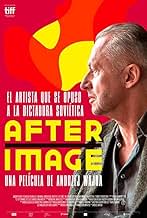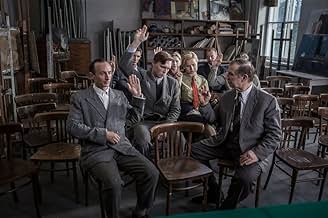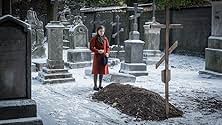La storia del pittore carismatico Wladyslaw Strzeminski, che si oppose al realismo sociale e mantenne la propria libertà artistica nonostante gli ostacoli politici.La storia del pittore carismatico Wladyslaw Strzeminski, che si oppose al realismo sociale e mantenne la propria libertà artistica nonostante gli ostacoli politici.La storia del pittore carismatico Wladyslaw Strzeminski, che si oppose al realismo sociale e mantenne la propria libertà artistica nonostante gli ostacoli politici.
- Regia
- Sceneggiatura
- Star
- Premi
- 2 vittorie e 12 candidature totali
Recensioni in evidenza
The film scenes are precise and the transitions between them are remarkably fluid, scary good! The acting is exemplary. The actors are cast perfectly, especially the main actor and the young woman who portrays his long-suffering daughter. Such wonders are the marks of a masterful director. Wajda died just after the completion of the film. Wajda was the trusting sort, said a friend of his, just before the film began. Such trust in his crew paid dividends. Seen at the Miami International Film Festival.
There is one major difference though. Many of his previous films focused on political characters, they were about men who changed history, about victors at least at the historical scale - Danton, Walesa - even if they sometime paid with their lives. The hero of this film, the avant-garde Polish artist Wladyslaw Strzeminski was defeated by history, and the film is the story of his defeat, of his physical but also moral decay. It's a story quite typical about the manner Communist dictatorships in Eastern Europe treated their artists, and even if I did not know anything about him before this movie, his story was well known to me as the same fate (or worse in some cases) was imposed on artists who did not compromise in Romania where I was born and I lived half of my life. We see him at the beginning admired and valued as a teacher and artist, he also was a companion of modernist artists who were associated with the Russian revolution, but this did not help him either. He was not an anti-Communist, but he valued true art, could not accept enrollment of art as a tool for propaganda and the norms of the dogmatic 'realism', and his refusal to compromise cost him his teaching position, his membership in the artist's union, the very possibility of painting. The humiliating tentative to find a way to survive had no chance, the regime was still in the Stalinist period and crushed all opponents according to the principle 'the one who is not with us is against us'. Even the help and support of a handful of students who stood by their beloved teacher and mentor could not save him.
The lead role is played with a lot of restraint and dignity by Boguslaw Linda, his flame is interior, he shows the artist far from being a flawless person, actually sharing some of the guilt of not being able to maintain his family and especially help his teen daughter (exceptional acting of 14 years old Bronislawa Zamachowska). There are many very well constructed scenes, some of them full with details bringing back to life with controlled anger that dark period of transformation, when Poland and Eastern Europe were postponing hope for a few decades and were transitioning from one nightmare to another. Wajda's last film is not a testament, it's an integral part of his opus of work.
The film is about the cruelty of the Stalinist period and how it intervened and interfered in the private lives of the common citizen and all the more so in the sphere of art, which "had to serve the people and the final victory of socialism". There are no throats being cut, people being shot or hanged. No spanking. Everything takes place in and "orderly way", for strict rules must be followed. Or perhaps only almost always! This reminds us of Kieslowski's film about killing or the thick atmosphere of Arthur Koestler's "Darkness at noon". Little by little art, i.e. the protagonist, is being suffocated. It is like cutting his veins, but not at once, slowly, in slow motion. Let him bleed to death, but "naturally". That was really a very hard time and Andrzej Wajda knows what he is talking about, for he experienced it "on his own skin", as you say in Polish. A symbolic image summarizes the pic: the window in the artist's dwelling is suddenly veiled by a red banner. A painter can somehow bear poverty, but can he survive without light? Brushes, paint? Wajda's choice of the actor (Boguslaw Linda) to embody Wladyslaw Strzeminski, one of the great Polish artists and art professors of that period, was fundamental to the artistic value of the picture. Bearing also in mind the fact that he had to play a cripple, who had lost two limbs, certainly made his acting even more daunting. And the outcome is certainly impressive.
Another factor that helps sooth the dreariness of the artist's predicaments is the strong presence of the teenager actress (Bronislawa Zamachowska) who plays his daughter. Her seemingly matter of fact reactions to reality and only rare expressions of deeper feelings function as a balance between the drama we witness and the everyday chores or the mere sipping of tea. "There are holes in my shoes" or "You smoke too much". His adoring students, on the other hand, may represent what was left of hope in those days. Their solidarity with the aging, crippled professor was an omen of better times to come, for who can defeat youth? And who can defeat art? The material shabbiness of those times, when "all were equal, but some were more equal than others", with food rationing, very poor dwellings etc. is shown in detail. Some viewers used to cinematic tangibility may not appreciate some of Wajda's discreet, very subtle hints and symbolic images, but, no doubt, in artistic terms this pic is a comeback to his heydays.
Rio Film Festival 8th October, 2016 Tomasz Lychowski
The sustained official campaign of death by a thousand cuts inflicted on Strzemiński strongly recalls that depicted in Wajda's earlier 'Rough Treatment' (1978), to which 'Afterimage' often feels like a prequel. The earlier film, however, was an angry, brutally contemporary film, while 'Afterimage' - while vividly conveying the Orwellian nightmare that was Stalinist Poland - is a much mellower piece recalling the far-off days of Wajda's youth with a grace and energy wholly belying his astonishing age; and Andrzej Mularczyk's script gleams throughout with flashes of wry black humour. The film has few out and out villains, with most of Strzemiński's persecutors sympathetic but powerless to resist.
The jagged widescreen photography of Pawel Edelman and design by Marek Warszewski simultaneously evoke the monochromatic drabness of life under communism while often looking vaguely expressionistic, with odd flashes of colour skilfully deployed. (A particular visual highlight is the priceless scene early on in which his studio is saturated with red light from a banner of Stalin erected directly outside his window, to which his already characteristic response is guaranteed to get him into trouble.)
Bogusław Linda's performance as Strzemiński would be impressive enough even without the remarkable technical feat he accomplishes of nipping about on crutches minus his left arm and left leg, while Bronislawa Zamachowska is tremendous as his equally resilient and bloody-minded daughter Nika; truly a chip off the old block.
The last movie of Andrzej Wajda tells the story of one of the best artists of the 20th Century, Wladyslaw Strzeminski.
The movie states that the situation of a true artist is miserable in spite of the geography, language and culture. Wladyslaw Strzeminski is a great painter, and is suffering due to his personal views, during a great social reformation in Poland. He loose his job, artist license canceled, and ignored in every corner of life. Though his students try to support him, it doesn't make much use. Hungry and sick, a great artist faces the tough realities of life.
The performance of the cast are amazing. Boguslaw Linda as Strzeminski and all the remaining cast have done a wonderful job. Photography and direction is so superb.
I noticed the audience after the movie, they had tears in their eyes. It is so heart touching. Do not miss this movie, if you are a real movie freak!
Lo sapevi?
- QuizOfficial submission of Poland for the 'Best Foreign Language Film' category of the 89th Academy Awards in 2017.
- Citazioni
Wladyslaw Strzeminski: They praise the ones who suck up. They're silent about the real artists.
Julian Przybos: I spoke about this with Milosz. He also believes that an artist who can't speak with a full voice should be silent. Artists can be killed in two ways: either by talking about them too much or not at all.
- ConnessioniReferences L'uomo di marmo (1977)
- Colonne sonoreLandscape
Written by Andrzej Panufnik
Performed by Narodowa Orkiestra Symfoniczna Polskiego Radia w Katowicach
Conducted by Piotr Komorowski
I più visti
- How long is Afterimage?Powered by Alexa
Dettagli
- Data di uscita
- Paese di origine
- Siti ufficiali
- Lingua
- Celebre anche come
- Afterimage
- Luoghi delle riprese
- Aziende produttrici
- Vedi altri crediti dell’azienda su IMDbPro
Botteghino
- Lordo Stati Uniti e Canada
- 33.443 USD
- Fine settimana di apertura Stati Uniti e Canada
- 5832 USD
- 21 mag 2017
- Lordo in tutto il mondo
- 1.032.768 USD
- Tempo di esecuzione1 ora 38 minuti
- Colore
- Mix di suoni
- Proporzioni
- 2.35 : 1
Contribuisci a questa pagina




































